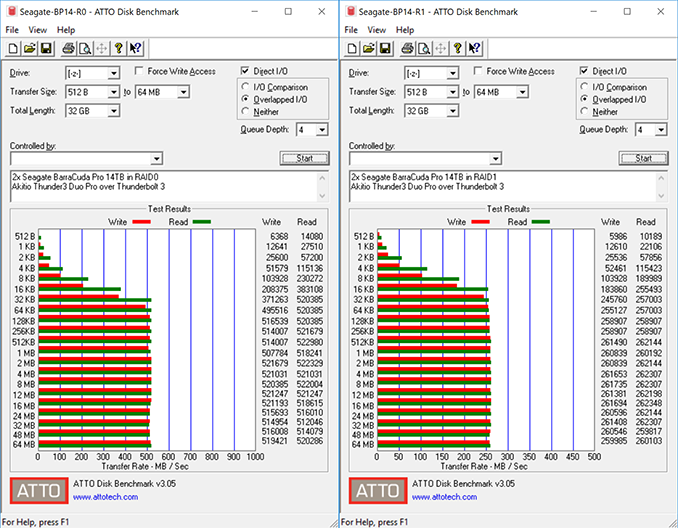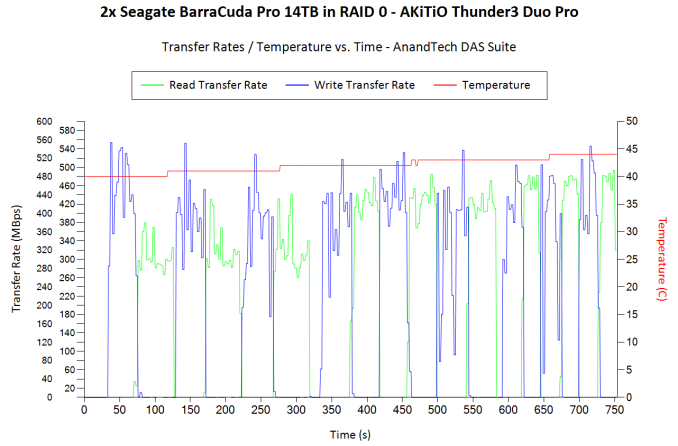Seagate BarraCuda Pro 14TB HDD Review: Massive Storage for Desktops
by Ganesh T S on September 10, 2018 8:01 AM ESTPerformance - Direct Attached Storage Mode
Seagate also sells the BarraCuda Pro Compute drives as being suitable for use in direct-attached storage systems. We evaluated the performance in such a usage scenario using one of the highest performing 2-bay DAS units currently in the market - the Akitio Thunder3 Duo Pro, connected to our testbed via a Thunderbolt 3 interface.
Prior to processing real-life workloads, we first checked quick artificial access traces using ATTO and CrystalDiskMark.
We find that the performance remains consistent irrespective of workload size as long as the sequential access characteristic holds. Two drives in RAID 0 can sustain 520 MBps+ reads and writes. RAID 1 performance is similar to the standalone drive performance.
Both RAID0 and RAID1 configurations were subject to our standard DAS test suite described in the previous section. The robocopy test suite gave the following results.
| Akitio Thunder3 Duo Pro + 2x Seagate BarraCuda Pro 14TB (Thunderbolt 3) robocopy Benchmarks (MBps) |
||||
| Write Bandwidth | Read Bandwidth | |||
| RAID 0 | RAID 1 | RAID 0 | RAID 1 | |
| Photos | 299.52 | 182.11 | 383.84 | 196.73 |
| Videos | 400.26 | 214.63 | 400.44 | 203.24 |
| Blu-ray Folder | 423.90 | 218.47 | 403.24 | 206.67 |
There is no difference in the performance consistency between either RAID configuration. The behavior is largely similar to the internal drive scenario, except for the RAID 0 absolute bandwidth numbers. Thanks to the enclosure's fan, the temperature increase is also not as much as what we observed in the internal drive case, though we do see the temperatures in the RAID 1 case being slightly more than the RAID 0 case due to the workload distribution.
We also processed select workloads from PCMark 8's storage bench.
| Akitio Thunder3 Duo Pro + 2x Seagate BarraCuda Pro 14TB (Thunderbolt 3) PCMark8 Storage Benchmarks (MBps) |
|||||
| Write Bandwidth | Read Bandwidth | ||||
| RAID 0 | RAID 1 | RAID 0 | RAID 1 | ||
| Adobe Photoshop (Light) | 297.55 | 206.27 | 10.26 | 9.31 | |
| Adobe Photoshop (Heavy) | 319.36 | 197.92 | 12.31 | 10.67 | |
| Adobe After Effects | 97.82 | 65.30 | 9.49 | 9.12 | |
| Adobe Illustrator | 224.29 | 178.66 | 9.06 | 8.81 | |
A significant speed-up in response time is achieved while dealing with multimedia files stored in a RAID 0 configuration of two BarraCuda Pro 14TB drives in a Thunderbolt 3 enclosure. Combined with the consistency shown, we can say that our results back up Segate's claims regarding the firmware tuning of BarraCuda Pro drives for specific application scenarios.














65 Comments
View All Comments
close - Monday, September 10, 2018 - link
It's not related to cost. Someone just knows RAID used to be a buzzword and he has to slip into the conversation to add weight to some dubious opinions.Seagate stands a lot better now reliability wise than it used to. Backblaze data seems to back this up. Drives don't "come" in RAID. You build it. Pretty sure he also goes for RAID 5 because it's "better", ""best performance/safety ratio".
bcronce - Monday, September 10, 2018 - link
RAID 5 and 6 don't protect from data corruption, just dataloss. ZFS has an custom implementation of RAID 5 and 6 that can detect corruption and figure out which source has an uncorrupted version.There are many other reasons than passive data corruption that can mess up your RAID 5/6.
wumpus - Tuesday, September 11, 2018 - link
Somehow I don't think I'm building a >40TB array with anything but ZFS (plus its own RAID).RAID is overblown and I'd expect more failures from things other than drives self-bricking. RAID's best feature is probably for yanking a drive due to SMART failures or aging out of an array. You'd have to take down a JBOD array to image a new drive from the one aged out. I wouldn't expect you to want to use the data from a drive yanked due to SMART failures. If you are just going to "build and forget" the array, RAID isn't buying you much.
If your network is up to it (it probably isn't), a good RAID should be able to handle the bandwidth of a large chunk of files being copied from an SSD (and easily should handle it if they are on the same computer, but that seriously limits your filesystem choices. Don't do that).
MrSpadge - Monday, September 10, 2018 - link
The value of data on a drive does not strictly depend on its size. Backup if it's important, don't if it's just temp storage or can easily be regenerated.Beaver M. - Tuesday, September 11, 2018 - link
Im running 2 12 TB not in RAID. Just using one of them as backup. Much safer than a RAID.No idea what youre talking about.
mapesdhs - Wednesday, September 12, 2018 - link
Are both drives in the same system? Hope you don't get a lightning strike. :}Just curious though, what's "safer" about doing it manually than simply using RAID1?
close - Thursday, September 13, 2018 - link
RAID 1 is the perfect way to ensure that any fcukup with the data on one drive is promptly replicated on the second one. In most normal cases performing a sync later is a much better option. A little more resistant to errors.eastcoast_pete - Monday, September 10, 2018 - link
Agree with others here that the list price is (way) too high, even for 14 TB. They need to bring that way down to be competitive on the price per Gb storage ratio.@Ganesh: Did you have a chance to ask Seagate about the reliability of these (very large) 'Cuda drives? Seagates Baracuda HDDs have had a, let's call it, "spotty" reliability over the last several years, also borne out in the survival stats at Backblaze. I would feel a lot more comfortable recommending these drives to customers if Seagate would be open about how they made sure that their drives are once again competitive with WD, Toshiba and, especially, HGST when it comes to reliability. A 5 year warranty is nice, but that means little if you end up spending days restoring > 7 TB from backups, which I hope you made frequently/daily. Remember, there are only two types of storage, regardless of technology: the one that failed, and the one that hasn't failed yet.
cjl - Tuesday, September 11, 2018 - link
Have you looked at any of the backblaze data in the past 2 years? The 6TB and up Seagates are doing excellently, as are the HGSTs, and WD is now the one trailing the pack. Obviously this one is too new to have any data yet, but the Seagate 6, 8, and 12TB drives are sitting around 1% AFR and the 10TB are down at 0.32% (though admittedly from a much smaller sample size - it looks like they pretty much skipped right over the 10TB generation and went straight for 12s, so the 10TB data is from only around a thousand drives).imaheadcase - Monday, September 10, 2018 - link
Kinda silly to run these in RAID for home use, especially since these sizes most likely be on a server and network will limit it anyways.